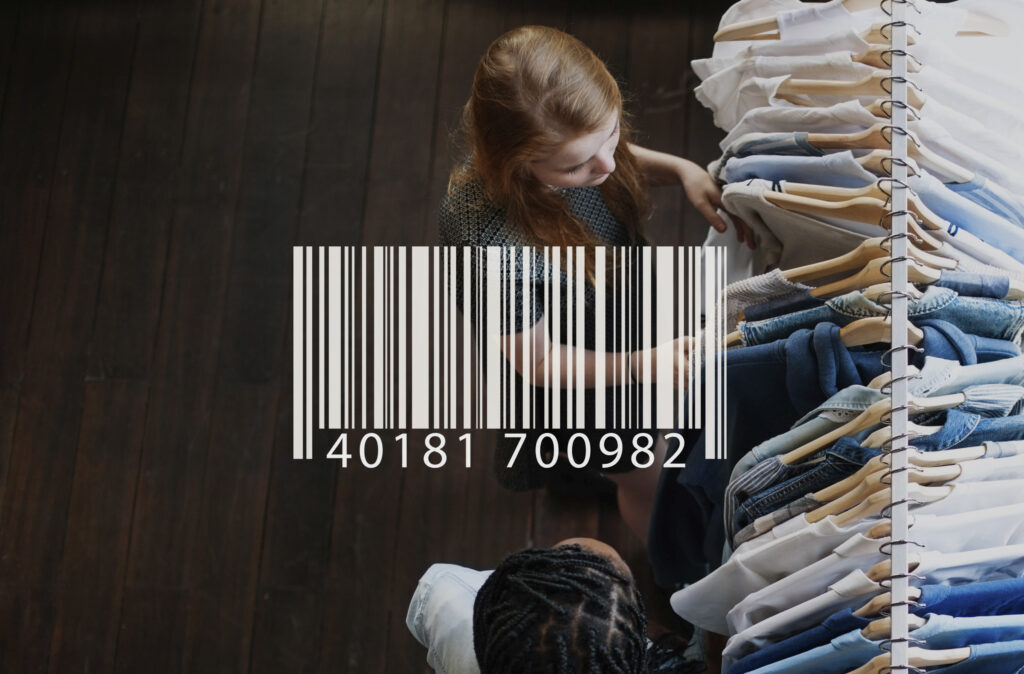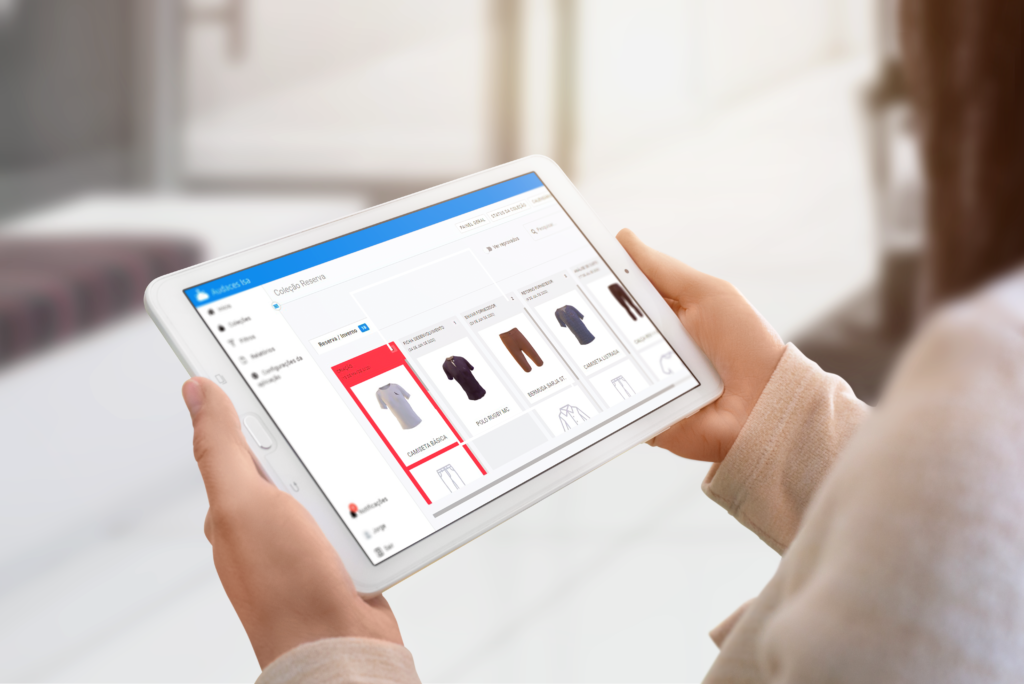Summary:
- Every product sold has a bar code to facilitate the control of internal and external processes;
- The GTIN consists of a numbering sequence beneath the barcode;
- Technology can help your company manage way better. Get the free trial of the Audaces360 multi-solution now and see the benefits!

The need to manage products correctly, enabling easy access for consumers, made the industry create a code to identify trade items, goods, or services, making their recognition unique.
This code can be scanned by machines and found by systems, facilitating operations.
To use this standard, there are some rules to be followed. In this post, you will learn more about what GTIN is, its importance for the fashion industry, and a few tips to apply in your company.
Read on!
Sumário
What is GTIN?
GTIN is popularly known as a barcode. The acronym means Global Trade Item Number, and it is a global standard used to uniquely identify any items ordered, priced, or invoiced within a supply chain.
It was created and administered by GS1, the organization that centralizes code generation worldwide, but each country has its own local office.
In physical retail, the GTIN is used to identify products; in digital, it is for distinguishing products from each other.
The numbers that appear just below the barcode can come in four different formats: 8, 12, 13, or 14 digits. But most GTIN data fields have 14 digits.
Read more: Find out how – and why – to apply textile automation in your company
What are the types of GTIN used in the apparel industry?
There are different types of GTIN and they are meant for situations that best fit your company.
Some details, such as the type of product, the location where the code will be, and logistical data, can influence the choice of the ideal code.
It is common for the product code to appear on the packaging; but, in the case of the apparel industry, it works differently. When it comes to clothing and accessories, the GTIN is usually on the product itself, attached to its tag.
For this reason, you need to figure out which option is the best for your company.
Check out the main types below:
- EAN/UPC: used on most consumer goods sold at point of sale (POS);
- GS1-128: allows encoding of various information and definitions, in addition to being widely used for logistic tracking;
- ITF-14: a specific 14-digit code for identifying trade items at various packaging levels (in shipping boxes, for example).
The Industry 4.0 era brings evolution but also increases data usage. This makes it a trend for the coming years to replace the barcode with the QR Code.
Learn more: How digital fashion design works and what are the benefits for the clothing industry?
What is the difference between GTIN, EAN and SKU?

The most common form in the world is the GTIN-13 – also known as EAN or EAN-13, an acronym applied formerly in Europe. That is purely a name change and does not affect any function of the barcodes.
The difference between GTIN and EAN is just the nomenclature in each continent, but the SKU is something different.
SKU means Stock Keeping Unit, which is a string of alphanumeric characters used to identify items and help with inventory management.
This combination is attached to a specific product that, thanks to this code, can be easily found.
The SKU is quite usual in physical stores, marketplaces, e-commerce platforms, and other companies that want to organize their stock.
The main difference between GTIN, EAN, and SKU is that the first two will always have a numeric sequence. On the other hand, the SKU can contain numbers and letters.
In addition, GTIN and EAN must be read and tracked by the barcode reader. The SKU is used for the internal organization of the stores.
Learn more: What is takt time and how to calculate it in your company?
How to know the GTIN of a textile product?
In order to avoid errors or misunderstandings, the GTIN constitution goes like this:
It starts with the GS1 prefix of the Company, which is assigned to the business when it joins GS1. After that comes the Item Reference, linked to the responsible for the product in the enterprise. And finally, we have the Verified Digit.
There are some basic elements that characterize an item that belongs to the textile industry. For example:
- Product type;
- Brand name;
- Material;
- Piece size;
- Color and/or print;
- Presentation method.
How to generate the GTIN code of the products you manufacture?
To generate the GTIN of your company products, you must have a GS1 registration. GS1 is the only authorized provider of GTINs in the world.
When registering, you will have access to some benefits and will be able to generate new and unique barcodes for your products, besides managing your data and other GS1 identification numbers.
After that, you’re all set and can start selling your items globally!
What are the benefits of the GTIN?
If you want to sell your products online, know that the GTIN is very important for your business and good performance.
When selling a product online different markets and retailers use the same GTIN, allowing them to compete equally.
The GTIN aims to help entrepreneurs organize their products and enable easy access to them.
See the improvements this code can bring to your business:
- Inventory control;
- Receiving automation;
- Order conference;
- Sending invoice;
- Unique code for product control;
- Sustainability;
- Traceability.
Learn more: What ESG score is and how to apply it to your clothing company
Boost your fashion business with the support of Audaces solutions

Technology applied in fashion brings a range of benefits to companies in the textile industry, and it can skyrocket their sales!
Audaces offers solutions with an innovative, complete concept that integrates several stages – from Creation to Production – for you and your business to have the best results.
Audaces360
Audaces360 is a complete multi-solution that helps you overcome the main challenges in the fashion industry.
With Audaces360, you can integrate all the creative and productive stages of your clothing, ensuring success from the very beginning of your fashion collection!
Our technology is designed to leverage the results of clothing businesses, generating more practicality, optimization of time, and agility in deliveries.
Shape-U
With Shape-U, you offer a better Customer Experience in your e-commerce and still count on a series of advantages, such as:
- Simple and user-friendly interface;
- Recommendations in a few steps;
- Comfort indication;
- Information on the recommendations made;
- Metrics of your business and target audience;
- Intuitive management panel;
- Performance reports on store recommendations.
Conclusion
All products sold need a barcode for internal control of the company and the generation of invoices.
There are several other benefits for your business when using the GTIN, such as the traceability of your product until it reaches the customer. And, of course, accuracy and cost savings.
Moreover, there is always something else to do to enhance a clothing company’s potential. Market innovations are here to remind us of that! And to show us plenty of options to consider and to keep modernizing and diversifying our business.
Have you ever thought of fashion tailoring, by the way?
Audaces can show you how technology can make this labor easier and more profitable! Download our e-book for free, and get to know how this activity can increase your production:
FAQ
The acronym means Global Trade Item Number, and it is a global standard used to uniquely identify any items ordered, priced, or invoiced within a supply chain.
To generate the GTIN of your company products, you must have a GS1 registration. GS1 is the only authorized provider of GTINs in the world.
There are some basic elements that characterize an item that belongs to the textile industry. For example: product type, brand name; material; the size of the piece; the color or the print.










